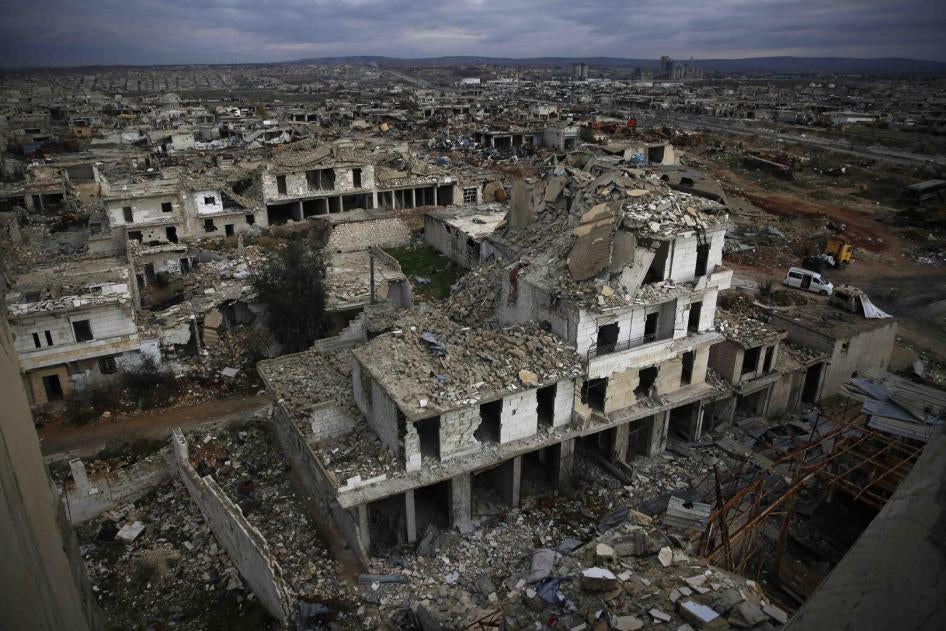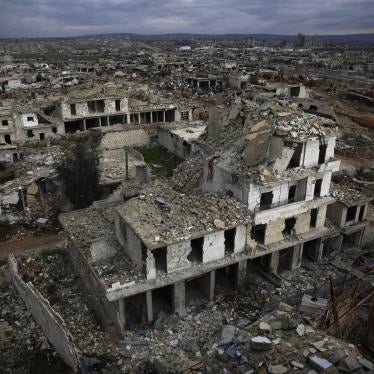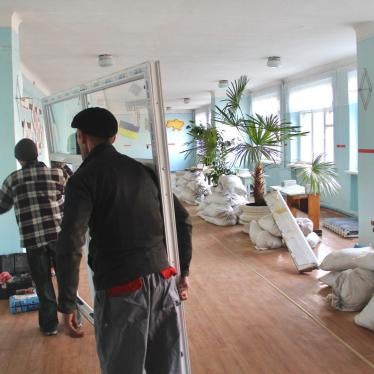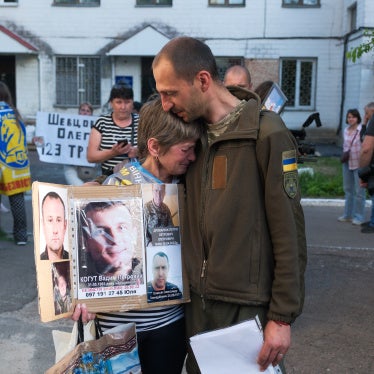Summary and Recommendations
States are currently engaged in a political process to address the consequences of using explosive weapons in populated areas. That process was launched in October 2019 when more than 130 states gathered in Austria for the Vienna Conference on the Protection of Civilians in Urban Warfare.
Political declarations are documents in which states commit to achieving political goals through individual and coordinated action. Although not legally binding, these political commitments carry significant weight. They outline standards for state conduct and clarify existing international law. They shape state behavior and advance a common goal.
The current process toward a political declaration aims to address the use of explosive weapons in populated areas, particularly weapons with wide area effects. When explosive weapons are used in populated areas, they cause immediate and long-term harm to the civilian population and civilian infrastructure.
To inform the content of a new political declaration, Human Rights Watch and Harvard Law School’s International Human Rights Clinic have conducted a study of existing declarations. Focusing on political declarations related to the conduct and consequences of armed conflict (see appendix for a complete list), they assessed the structure and components of these documents. This report identifies seven key components that are common to armed conflict-related political declarations: an introduction identifying the problem of concern and six categories of commitments.
This report examines each of these components. It describes what the component entails; lays out the precedent, found in existing conflict-related declarations, for including it; discusses how that component could be applied in the forthcoming political declaration on the use of EWIPA; and explains the value of the component in bolstering political declarations and states’ movement toward common goals. The commitments proposed by the International Network on Explosive Weapons (INEW), a civil society coalition co-founded by Human Rights Watch and other nongovernmental organizations (NGOs) in 2011, parallel the structure identified in this report.
Based on their study, Human Rights Watch and the Harvard Law School International Human Rights Clinic recommend that a political declaration on the use of EWIPA draw on the model of previous conflict-related declarations and include the following components:
- Adoption of practical measures that concretely address EWIPA-related harms;
-
Assistance for victims of past and future explosive weapons use;
-
Adoption and promulgation of laws and policies to prevent and remediate the harm caused by explosive weapons;
-
Gathering and sharing of disaggregated data to track the problems associated with use of EWIPA and progress toward addressing them; and
-
Establishment of a framework for continued engagement around the use of EWIPA.
Each of the five specific commitments represents a category of commitments rather than a single commitment. For example, “Adoption of practical measures” might include three, five, or even ten separate, concrete measures that states commit to adopt in pursuing the general commitment to address the problem.
Introductory Section
Description and Precedent
Each of the armed conflict-related political declarations reviewed for this report includes an introductory section that provides context for the declaration and that is followed by a series of commitments. The introduction usually includes a statement of the problem the declaration aims to alleviate and refers to existing international law and parallel efforts to address the problem.
The problem statements lay out the key issues the declarations seek to address and why those issues matter. The 2010 Oslo Commitments on Armed Violence, for example, begin by identifying armed violence as “a fundamental challenge to our common humanitarian and development goals.”
Many political declarations dealing with armed conflict also cite widely endorsed treaties, especially the Geneva and Hague Conventions, in their introductions. These declarations tend to invoke international law in three different ways. First, they frequently highlight how the practice of concern in the declaration is already violating international law, and in so doing, bolster the case for a response. The 2013 Declaration of Commitment to End Sexual Violence in Conflict, for example, notes that “rape and other forms of serious sexual violence in armed conflict … constitute grave breaches of the Geneva Conventions and their first Protocol.”
Declarations also frequently note parallel efforts that advance the same objectives. The 2015 Safe Schools Declaration, for example, welcomes the non-binding Guidelines for Protecting Schools and Universities from Military Use during Armed Conflict, which “draw on existing good practice” and “provide guidance” to reduce the impact of armed conflict on education.
Application to an EWIPA Declaration
A problem statement on the use of EWIPA, especially those with wide area effects, should highlight the documented pattern of harm to civilians and civilian objects. In particular, the problem statement should spotlight the high incidence of civilian death and injury, infliction of psychological distress, damage to essential infrastructure, interference with health care and education, generation of displacement on a large scale, degradation of the environment, denial of humanitarian access, and contamination of territory with explosive remnants of war.
An EWIPA political declaration should also include references to existing international law. International humanitarian law requires parties to a conflict to distinguish between civilians and combatants and prohibits the infliction of disproportionate harm.
A political declaration could also note parallel efforts to recognize and address the problem of EWIPA. In particular, it could cite the UN Secretary-General’s annual protection of civilian reports and the recent Agenda for Disarmament, both of which recognize the harm caused by the use of EWIPA.
Value of Introductory Sections
The introduction of a political declaration provides a touchstone for the general and specific commitments that follow by describing the problem at issue and placing it in a legal context. The introduction allows states to unite around clear and common concerns while setting the stage for the work they agree to do separately and together in furthering their shared objective. The problem statement in particular can provide extra motivation for states to endorse and robustly implement the declaration. Finally, references to existing international law and parallel efforts bolster the political declaration by providing a strong grounding in states’ pre-existing commitments and situating new commitments in a broader context.
General Commitment to Address the Problem
Description and Precedent
Political declarations often include a general commitment to address the problem identified in the introduction. The broadest commitment of a declaration, it presents the document’s primary objective. In so doing, it can help frame the remaining, more specific commitments that seek to advance that goal. General commitments sometimes appear as part of the introduction, and sometimes within the list of commitments that follows.
General commitments in conflict-related political declarations take a variety of different forms. For example, countries can commit to “end” a problem, “spare no effort to end” a problem, or “promote” solutions to a problem.
Sometimes these general commitments include multiple parts that elaborate on how states will achieve a broader aim. For instance, in the 2013 Declaration of Commitment to End Sexual Violence in Conflict, countries state that “[b]y working together, sharing our knowledge and our experience, mobilising resources and committing our global political will we are determined to end the use of rape and other forms of sexual violence as weapons of war.”
Application to an EWIPA Declaration
In an EWIPA declaration, states should commit to stop the use of explosive weapons with wide area effects in populated areas. Wide area effects, which exacerbate the harm caused by the use of EWIPA, are attributable to the inaccuracy of a weapon, a large blast radius, and/or the delivery of multiple munitions at the same time. While the exact wording remains to be determined, a commitment to “stop” the use of EWIPA with wide area effects would have the greatest humanitarian impact because of the strength of the language.
Another proposal on the table is a general commitment to “avoid” the practice. The so-called avoidance policy proposed by the ICRC relates to international humanitarian law’s principle of proportionality. That principle prohibits attacks in which the expected harm to civilians and civilian objects would be excessive compared to the anticipated military advantage.
Value of General Commitments
A strong general commitment can be the most critical pledge within a political declaration. The general commitment serves as a core mission statement and focuses the efforts of endorsing countries. It can also create cohesion among countries that endorse the declaration and agree to work toward a common objective. This commitment can further influence non-endorsing states and non-state actors by clarifying and crystallizing norms while generating stigma around unacceptable behavior.
Adoption of Practical Measures
Description and Precedent
Commitments to adopt practical measures identify specific, concrete steps that states agree to take to implement the general commitment or achieve the broader goals of the political declaration. These commitments are more precise and action oriented than a general commitment.
Because of their specificity, commitments to adopt practical measures vary widely depending on the problem a declaration targets. Some are directed at national programs designed to advance the declaration’s objective. For example, the 2013 Declaration of Commitment to End Sexual Violence in Conflict commits states to “[e]nsur[ing] that sexual violence prevention and response efforts are prioritised and adequately funded.”
Political declarations also commit states to take practical steps at the international level. For example, in the 2015 Safe Schools Declaration, states pledge “where in a position to do so, [to] provide and facilitate international cooperation and assistance to programmes working to prevent or respond to attacks on education.”
Application to an EWIPA Declaration
Commitments to adopt practical measures could take various forms in an EWIPA declaration. To prevent the harm caused by the use of EWIPA and implement the general commitment, they should encourage states to exchange best practices and update training and equipment, steps that would help improve civilian protection in urban warfare. To remediate harm that has occurred, the commitments should call on states to sponsor protection measures that enable communities to better reduce harm on their own, support the timely clearance of areas contaminated by explosive remnants of war, and promote and ensure unimpeded access to inclusive humanitarian aid. At an international level, the commitments should encourage states to provide international cooperation and assistance.
Value of Adopting Practical Measures
Commitments to adopt practical measures identify critical action areas that are designed to address the overarching problem. These types of commitments supplement the broad general commitment by specifying action areas for states to prioritize when working to address the problem.
Enumerating concrete actions to be taken makes it easier for states to implement the political declaration in an effective and timely manner. Furthermore, given that progress toward the general goals can be harder to assess, these specific commitments provide metrics against which countries can judge their progress and the progress of others.
Victim Assistance
Description and Precedent
Most political declarations related to armed conflict include commitments to assist victims harmed by the activities or weapons that are the focus of the declaration. Victim assistance encompasses a wide range of measures devoted to remediating ongoing human suffering regardless of when it was caused. In particular, it includes emergency and continuing medical care, physical rehabilitation, psychological and psycho-social support, measures to ensure the social and economic inclusion of survivors, and the adoption or adjustment of relevant laws and public policies supported by data collection and analysis.
An integrated approach realizes victim assistance through wider development, human rights, and humanitarian efforts, in addition to specific initiatives aimed at addressing the needs of survivors.
The concept of victim assistance originated and has been codified in disarmament treaties. The 1997 Mine Ban Treaty commits states parties to provide assistance for people harmed by a specific type of weapon in its preamble and its provision concerning international cooperation.
Victim assistance has also been incorporated in many political declarations. For example, in the 2010 Oslo Commitments on Armed Violence, states committed to “[r]ecognise the rights of victims of armed violence in a non-discriminatory manner, including provision for their adequate care and rehabilitation, as well as their social and economic inclusion, in accordance with national laws and applicable international obligations.”
In addition to the provision of services for critically injured individuals,
Application to an EWIPA Declaration
A political declaration on EWIPA should include a commitment to recognize the rights of victims, including individuals, their families, and affected communities, and to provide them services. Humanity & Inclusion, an NGO with particular expertise in this area,
Humanity & Inclusion also recommends complementary remedial commitments on reconstruction of public infrastructure, unimpeded access to principled and inclusive humanitarian aid, international cooperation and assistance, risk education, and the clearance of explosive remnants of war.
Value of Assisting Victims
Including a robust commitment to victim assistance addresses the needs and protects the rights of those most affected by the harm addressed in a political declaration. It is also key to ensuring a comprehensive and long-term response to the problem.
At the same time, a commitment to assist victims can bolster cooperation and support for affected states. Effective victim assistance often relies on the mobilization of both national and international resources. Countries experiencing violence related to armed conflict are not always well-positioned to respond quickly to the needs of victims within their borders. A commitment to support affected states with the provision of victim assistance helps bridge that gap and ensure that services reach those who need it most.
Adoption and Promulgation of Laws and Policies
Description and Precedent
Political declarations usually include commitments to adopt and promulgate laws and policies. This kind of commitment can involve national or international measures, or both.
Many armed conflict-related political declarations include commitments for endorsing states to take action at the national level, including by ensuring that domestic law and policy are consistent with pledges made in the declaration. For example, the 2017 Political Declaration on the Protection of Medical Care in Armed Conflict includes an agreement stating that “[endorsing states will review] national legislation, policies and procedures relevant to the protection of medical care in armed conflict.”
Commitments on laws and policies can, and usually do, encourage action at the international level, such as by calling for the development of new international law. For example, in the 2006 Geneva Declaration on Armed Violence and Development, parties agree to “[promote] the development of further international instruments, including legally binding ones.”
Application to an EWIPA Declaration
In an EWIPA political declaration, commitments to adopt and promulgate laws and policies could include a number of different items. For example, the declaration should include a commitment that endorsing states will review and adapt their domestic military policies to ensure they are in line with the principles of the declaration. Similarly, it should include a commitment that endorsing states adopt legal and administrative measures to provide victim assistance. On the international level, the declaration could encourage the development of other international agreements or guidelines down the road.
Value of Adopting and Promulgating Laws and Policies
There are numerous reasons to include commitments to adopt and promulgate laws and policies in a political declaration. Whether legally binding or not, international agreements are most effective when they are accompanied by national implementation measures. For example, agreeing to review and, if necessary, amend national military codes and policies can help ensure the most relevant actors have internalized the political declaration’s commitments. By encouraging the development of law and policy at the national level, this kind of commitment shows respect for state sovereignty. It acknowledges that states may know best how to tailor the measures of the declaration to fit their own national systems and circumstances.
A commitment to adopt and promulgate laws and policies at the international level can also have benefits. It can lead to further development of international law or standards at a later stage. In the interim, it can build and bolster legal standards and norms, thus extending the commitment’s impact beyond the states that endorse a particular declaration. By crystallizing international norms, such a commitment can influence the conduct of states that have not endorsed the declaration and non-state actors, including non-state armed groups that seek legitimacy on the international stage. In addition, civilian victims from non-endorsing states might benefit from international assistance or at least from the public recognition of the harm they suffered.
Data Gathering and Sharing
Description and Precedent
Armed conflict-related political declarations often include a commitment to support and improve the collection and sharing of data. Relevant data can include the number of casualties, disaggregated by sex, age, and ability, and the incidence of other types of harms. For example, endorsers of to the 2013 Declaration of Commitment to End Sexual Violence in Conflict pledge to “[e]ncourage and improve the safe and ethical collection of data and evidence relating to acts of sexual violence committed in conflict, to inform national and international responses.”
Application to an EWIPA Declaration
In the context of EWIPA, a political declaration should include a commitment to undertake and support others in undertaking data gathering and reporting. The data collected should encompass the use of explosive weapons in populated areas, the type of weapon used, casualties, and the destruction of civilian infrastructure and housing.
Some states already collect data related to EWIPA use. For instance, states parties to Protocol V on Explosive Remnants of War to the Convention on Conventional Weapons are obligated to collect information on their own use of explosive ordnance in conflict.
Value of Gathering and Sharing Data
Data collection can improve implementation of the declaration’s other commitments. It helps assess the effectiveness of the declaration and what further steps could be taken to strengthen the content of and compliance with the commitment. Data may also inform the design and updating of relevant programs as needed. For example, detailed data can provide states with lessons for future operations, with the goal of mitigating civilian harm. If, as discussed below, states convene further meetings focused on the issue or on the declaration’s implementation, it is particularly useful for states and supporting NGOs to have information on the declaration’s effectiveness and progress toward achieving its goals.
Collection and publication of accurate information also benefits victims. It provides ongoing recognition of the harm victims experience. In so doing, it can honor survivors and bolster efforts to mitigate or remedy their suffering. Reliable data on the numbers of victims and their circumstances, as well as information about affected communities, further facilitates the provision of victim assistance, which is discussed above. In addition, by spotlighting ongoing problems, as well as progress spurred by the declaration, the data encourages more states to join a declaration.
Finally, a commitment to gathering and sharing data allows for monitoring of progress and promotes accountability among states. Monitoring sheds light on compliance, both with relevant existing international law and with the new political commitments in the declaration. The information gathered can then help hold states responsible for implementing their legal obligations and political commitments. For example, in the 2007 Paris Commitments to Protect Children from Unlawful Recruitment or Use by Armed Forces or Armed Groups, the monitoring efforts that states commit to supporting are aimed at uncovering “violations of child rights in armed conflict, including the unlawful recruitment or use of children.”
Establishment of a Framework for Continued Engagement
Description and Precedent
Most political declarations include a commitment that endorsing states will continue engaging with the problem at hand. Such commitments often take the form of agreements to convene the group that negotiated the political declaration along with states that more recently endorsed the declaration.
These commitments can specify the regularity by which future meetings will occur, actual dates and/or locations for future meetings, the general need to reconvene, or any combination of these agreements. For example, the 2006 Geneva Declaration on Armed Violence and Development includes a commitment to “meet[] again no later than 2008 to assess our progress in achieving these goals.”
Commitments that establish a framework for continued engagement frequently identify specific reasons why further work is necessary. The 2016 Joint Declaration for the Export and Subsequent Use of Armed or Strike-Enabled Unmanned Aerial Vehicles, for example, highlights the need for states that have endorsed the declaration to keep international standards up to date with “the rapid development of UAV technology.”
Application to an EWIPA Declaration
A political declaration on the use of explosive weapons should include a commitment for the states that are endorsing the declaration to meet again regularly. The commitment could also specify that discussions at these future meetings should focus on sharing information gathered, exchanging best practices, and determining what, if any, changes are necessary to strengthen implementation measures currently being undertaken. In particular, at these future meetings, states could analyze the ongoing use of explosive weapons and whether current measures associated with the declaration are sufficient.
Value of Establishing a Framework for Continued Engagement
Committing to establish a framework for continued engagement can be useful in several ways. First, such a commitment creates a framework for sharing ideas and information related to the declaration and its implementation. States can review the data gathered regarding the status of the problem being addressed and the progress made toward addressing it. This information can help states assess the adequacy of the political declaration and consider whether additional steps are needed. States can also exchange best practices and lessons learned regarding the operationalization of other commitments.
Second, like the data-gathering commitment, a commitment to continue engagement can facilitate compliance monitoring and promote accountability. The prospect of regular meetings can motivate states that have endorsed the declaration to achieve certain goals before they report to their peers. These meetings provide an opportunity to determine which states may need international assistance in order to achieve their political commitments. Continued engagement also normalizes and reifies the principles laid out in the declaration.
Third, a commitment to engage gives states the opportunity to address issues that they did not have the time or political will to address during the declaration drafting period.
Fourth, this kind of commitment creates an opportunity for parties to foster relationships and build on the political declaration. For example, a plan to meet again can provide a forum for states that are interested in developing other agreements complementary to the declaration in the future.
Appendix
Political Declarations Analyzed
Declaration of Commitment to End Sexual Violence in Conflict, 2013: Declaration to end rape and sexual violence in armed conflict.
Declaration on Anti-Vehicle Mines, 2006: Declaration developed through the forum of the Convention on Conventional Weapons calling on governments to limit their use of anti-vehicle mines.
Declaration on Cluster Munitions, 2006: Declaration developed through the forum of the Convention on Conventional Weapons calling for an agreement to prohibit cluster munitions.
G8 Declaration on Preventing Sexual Violence in Conflict, 2013: Declaration in which G8 foreign ministers recognize the need to work together to end sexual violence in conflict.
Geneva Declaration on Armed Violence and Development, 2006: Declaration to curb the negative effects of armed violence on development.
Joint Declaration for the Export and Subsequent Use of Armed or Strike-Enabled Unmanned Aerial Vehicles (UAVs), 2016: Declaration identifying principles to ensure the responsible export and subsequent use of unmanned aerial vehicles (UAVs).
Oslo Commitments on Armed Violence, 2010: Declaration outlining measures to prevent and reduce armed violence.
Paris Commitments to Protect Children from Unlawful Recruitment or Use by Armed Forces or Armed Groups, 2007: Declaration to end the recruitment and use of children by armed forces or armed groups.
Political Declaration on the Protection of Medical Care in Armed Conflict, 2017: Declaration to enhance protection of, and prevent acts of violence against, medical and humanitarian personnel.
Safe Schools Declaration, 2015: Declaration on preventing attacks on education during armed conflict, which includes endorsement of Guidelines for Protecting Schools and Universities from Military Use during Armed Conflict.








